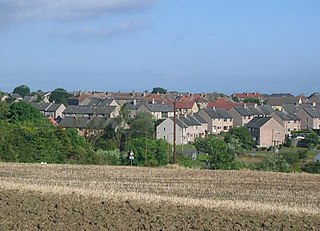Activities
The society's aims include:
- promotion of co-operation between all canal users
- support for the sympathetic and sustainable development of the waterway and its environment
- provision of volunteering opportunities for all ages
- protection of natural habitats of the canal
- encouragement of leisure use by the community including people with disabilities.

According to many definitions, a disability is an impairment that may be cognitive, developmental, intellectual, mental, physical, sensory, or some combination of these. Other definitions describe disability as the societal disadvantage arising from such impairments. Disability substantially affects a person's life activities and may be present from birth or occur during a person's lifetime.
Disabilities is an umbrella term, covering impairments, activity limitations, and participation restrictions. An impairment is a problem in body function or structure; an activity limitation is a difficulty encountered by an individual in executing a task or action; while a participation restriction is a problem experienced by an individual in involvement in life situations. Disability is thus not just a health problem. It is a complex phenomenon, reflecting the interaction between features of a person’s body and features of the society in which he or she lives.
Along with the Seagull Trust, the Linlithgow Union Canal Society, the Edinburgh Canal Society, Forth Canoe Club and other canal-based community groups and charities, Bridge 19-40 Canal Society has campaigned for the retention, renovation and re-use of the Scottish Lowland canals.
Seagull Trust Cruises is a waterway society and Scottish charity.
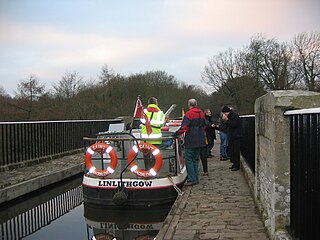
The Linlithgow Union Canal Society is a waterway society and a Scottish registered charity based at Linlithgow Canal Centre on the Union Canal at Linlithgow, West Lothian, Scotland. Also known as "LUCS", it was founded in 1975 by Melville Gray to "promote and encourage the restoration and use of the Union Canal, particularly in the vicinity of Linlithgow".

The Edinburgh Canal Society is a charitable canal society on the Union Canal in Edinburgh, Scotland. The Society's main base is Ashley Terrace Boathouse at Lockhart Bridge, near Harrison Park in the Polwarth area of Edinburgh.
Bridge 19-40 regularly organises Water Safety trips for primary schools in West Lothian; their aim is to raise awareness among children about the potential dangers of water, and to discourage litter on the waterway.
This page is based on this
Wikipedia article Text is available under the
CC BY-SA 4.0 license; additional terms may apply.
Images, videos and audio are available under their respective licenses.
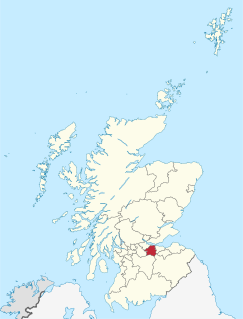
West Lothian is one of the 32 council areas of Scotland, and one of its historic counties. The county, which was also known as Linlithgowshire, was bounded by the Avon to the west and the Almond to the east. The modern council area occupies a smaller area, with areas in the west transferred to Falkirk and areas in the east transferred to Edinburgh following local government reforms in the late 20th century. It did however gain areas from Midlothian.

The Forth and Clyde Canal is a canal opened in 1790, crossing central Scotland; it provided a route for the seagoing vessels of the day between the Firth of Forth and the Firth of Clyde at the narrowest part of the Scottish Lowlands. It is 35 miles (56 km) long and it runs from the River Carron at Grangemouth to the River Clyde at Bowling, and had an important basin at Port Dundas in Glasgow.

Broxburn is a town in West Lothian, Scotland located 12 miles (19 km) west of Edinburgh on the A8 road, 5 mi (8 km) from Edinburgh Airport, and to the north of Livingston.

The canals of the United Kingdom are a major part of the network of inland waterways in the United Kingdom. They have a colourful history, from use for irrigation and transport, through becoming the focus of the Industrial Revolution, to today's role of recreational boating. Despite a period of abandonment, today the canal system in the United Kingdom is again in increasing use, with abandoned and derelict canals being reopened, and the construction of some new routes. Most canals in England and Wales are maintained by the Canal & River Trust, previously British Waterways, but a minority of canals are privately owned.
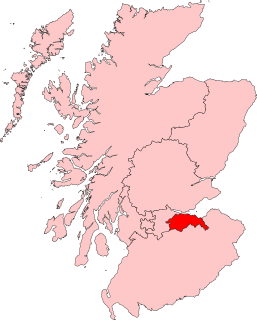
Linlithgow is a constituency of the Scottish Parliament (Holyrood). It elects one Member of the Scottish Parliament (MSP) by the plurality method of election. Also, however, it is one of nine constituencies in the Lothian electoral region, which elects seven additional members, in addition to nine constituency MSPs, to produce a form of proportional representation for the region as a whole.

The Forth and Clyde canal pathway runs between the Firth of Forth and the Firth of Clyde and is a 106-kilometre (66 mi) long footpath and cycleway that runs across Scotland, between Bowling, west of Glasgow, and Lochrin Basin in Edinburgh. The path runs on the towpaths of the Forth & Clyde and Union Canals and is entirely off road. The path is well maintained and its surface is generally good, although there are some stretches particularly between Falkirk and the outskirts of Edinburgh where wet weather leads to muddy conditions unsuitable for road intended bicycles. It is well used by walkers and cyclists, and designated as one of Scotland's Great Trails by Scottish Natural Heritage. It also forms part of the National Cycle Network, being designated as Route 754. Sustrans advises that the path is best followed from the Clyde to the Forth because the prevailing wind is from the south west. Much of the path is also suitable for experienced horseriders, although in some places low bridges, narrow aqueducts and gates may restrict access for horses.

Newbridge is a village within the parish of Kirkliston, to the west of Edinburgh, Scotland. It originally lay on the western edge of the county of Midlothian; however, local government reforms in the late 20th century placed it within the jurisdiction of the City of Edinburgh Council.
St Mary's Academy, Bathgate was a former Roman Catholic High School located in the Eastern part of Bathgate, West Lothian in Scotland. It was a state funded High School that educated young adults mainly from the areas of Bathgate, Armadale, Blackridge, Linlithgow, Bo'ness, Stoneyburn and Bents, Blackburn, Seafield, Polbeth, West Calder, Addiewell, Faulhouse, Longridge, Whitburn, East Whitburn, Harthill, Greenrigg and parts of Livingston, Broxburn, Winchburgh, Kirkliston and Ratho Station. The School Motto was 'Animo et Fide' which translates from Latin as Courageously and Faithfully. The School was located on Edinburgh Road, Bathgate.

Linlithgow Academy is a secondary school in Linlithgow, West Lothian, Scotland. The original Academy was built in 1900 to a design by James Graham Fairley and replaced an earlier kirk institution, known as "Sang Schule".
The Millennium Link is one of the biggest engineering projects ever undertaken by British Waterways. The Union Canal and the Forth & Clyde Canal were originally joined by a flight of locks. The Millennium Link project replaced the locks with a boat lift, the Falkirk Wheel.

The Scottish Inland Waterways Association (SIWA) was a registered charity and association of canal societies and individual canal enthusiasts in Scotland.
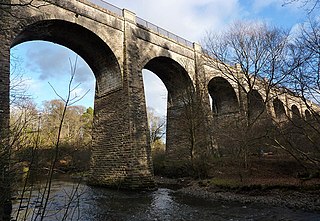
The Avon Aqueduct is a navigable aqueduct that carries the Union Canal over the River Avon, near Linlithgow, Scotland.



